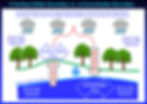Why two boundaries?
- Todd Giddings, Ph.D., P.G.
- Jan 11, 2017
- 1 min read
The Spring Creek Watershed has two types of watershed boundaries as shown on this cross-section diagram.
The surface-water boundary is on the left and the groundwater boundary on the right. The headwater area of the Big Spring in Bellefonte has its western boundary in the Spruce Creek Surface-Water Watershed. When rainfall and snowmelt water infiltrate into the ground in the Spruce Creek Surface-Water Watershed as shown by the blue drop of water above, this water percolates downto become groundwater recharge. This groundwater recharge water flows to the east and discharges from the Big Spring in the Spring Creek Groundwater Watershed. Arrrrgh! This stealing of water from beneath the Spruce Creek Surface-Water Watershed is called groundwater piracy. This groundwater piracy takes place because in this area of the Spring Creek Surface-Water Watershed, the groundwater boundary is beyond the surfrace-water boundary. In most other areas of the Watershed, these two boundaries are coincident.
This map shows the groundwater boundary (red line) and the surface-water boundary (purple line) of the Spring Creek Watershed. Where the two boundaries are coincident, there is a single red line shown. The blue dot in Bellefonte is the location of Big Spring, and the black dashed-line is the location of the Birmingham Thrust Fault in the subsurface. The white line is the location of the cross-section shown in the diagram above, and the arrows show the direction of view.
The land area between the surface-water boundary and the groundwater boundary is the headwater area of the Big Spring in Bellefonte.

The Big Spring pool looked like this before it was fitted with a floating cover.
The author of this information is toddgiddings@verizon.net .



